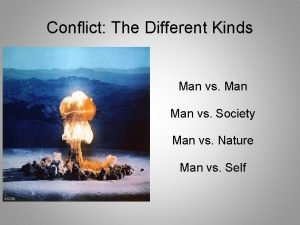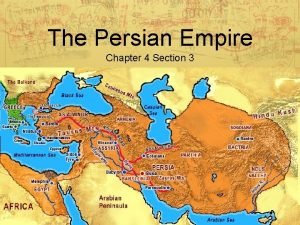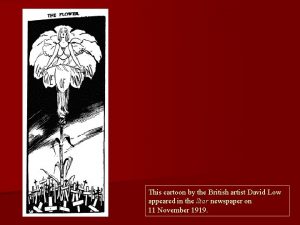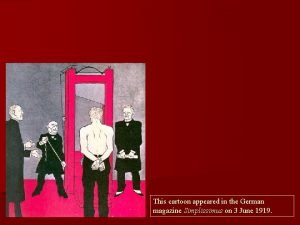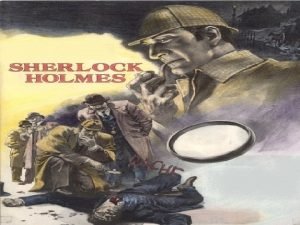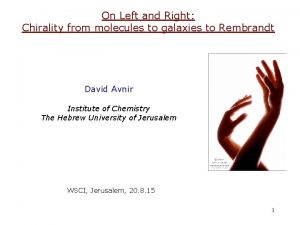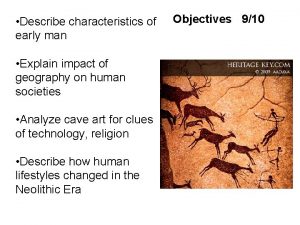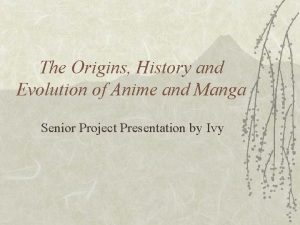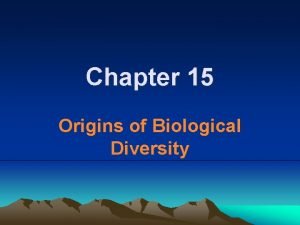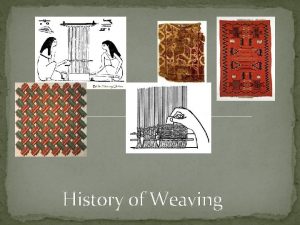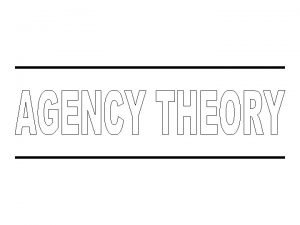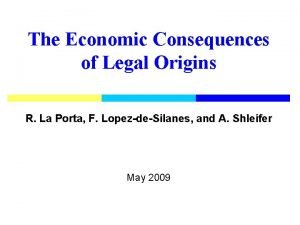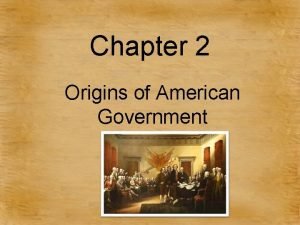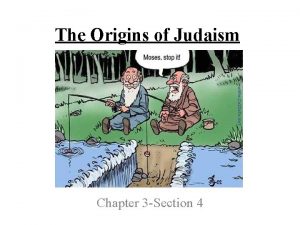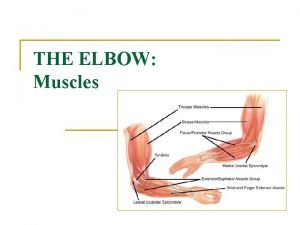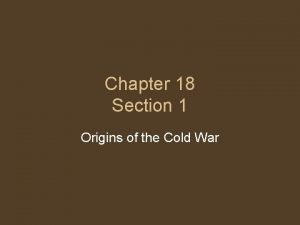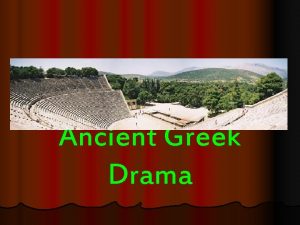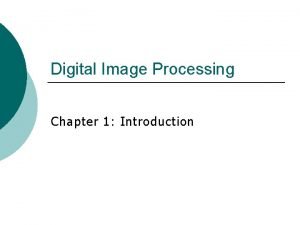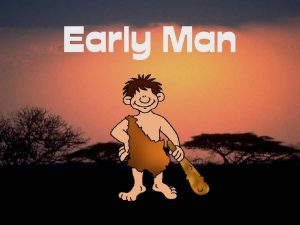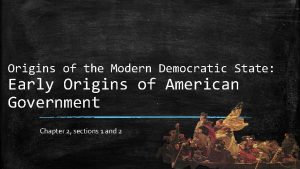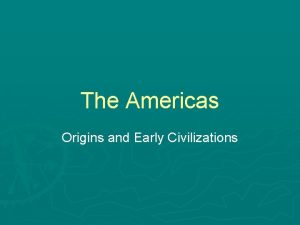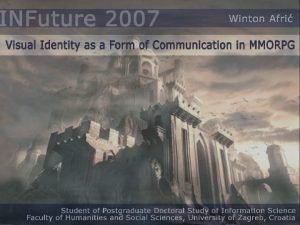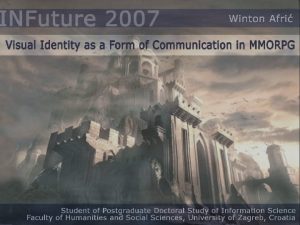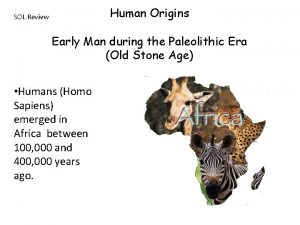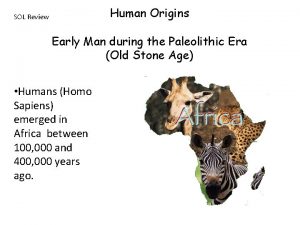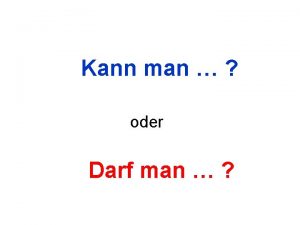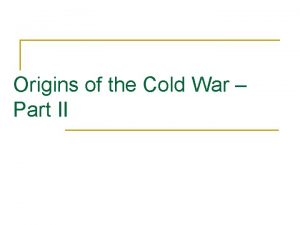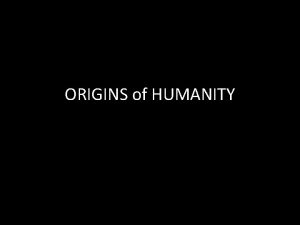Origins of Man The Early Man n Appeared











































































- Slides: 75

Origins of Man

The Early Man n Appeared in east Africa n 4 million to 1 million BCE n Various forms of ‘man’ emerge; homo sapiens n Cro-Magnon people: n n Early modern man 40, 000 BCE Spread throughout Eurasia in 100, 000 BCE hunters & gatherers

Paleolithic Society Economy and society of hunting and gathering peoples n Economic life n Lived an egalitarian existence n Lived in small bands, about 30 to 50 members n Some permanent settlements

Paleolithic Culture n Careful burial rituals n Venus figurines n Sophisticated weapons n Jewelry n Cave paintings

The Neolithic Era n The origins of agriculture n From about 12, 000 to 6, 000 years ago n Neolithic women began systematic cultivation of plants n Neolithic men began to domesticate animals n Early agriculture around 9000 B. C. E. n Agriculture emerged independently in several parts of the world n Earliest cities in Mesopotamia, 4000 to 3500 B. C. E

Spread of Farming

Rise of ‘Civilizations’ and the Complex Society

Earliest Civilizations

Mesoptomia

Mesopotamia: "the land between the rivers" n Had to use irrigation n Few natural geographic boundaries n Food supplies increase Migrants to the area increase- mostly Semites n Cities emerge, 4000 B. C. E. n Governments sponsor building projects and irrigation n Internal problems as well as external problems n Attacks by others led to wall building and military development n

Politics

Sumer n first major city-state

Rise of Empire n Sargon of Akkad 2370 - 2315 B. C. E. n Seizes trade routes and natural resources n Hammurabi 1792 -1750 B. C. E. n n Capital is Babylon law of retribution and importance of social status

The Later Mesopotamian Empires n Assyrians 1300 -612 B. C. E. n Powerful army: chariots, archers, iron weapons n Nebuchadnezzar 605 - 562 B. C. E. n Hanging gardens of palace shows wealth and luxury

Economics

Trade n Economic specialization and trade n Bronze (made from copper and tin) n Iron (about 1000 B. C. E. ), n Wheel (3500 B. C. E. ) n Shipbuilding

Phoenicians n Occupy land north of Palestine (Canaan) n kingdoms of independent city -states emerge in 3000 BCE n Overland trade to Mesopotamia; influence on culture n Sea trade most important; get raw materials, trade for manufactured goods n alphabetical script (1500 B. C. E. )

Society

Social Classes n Social classes Seen from Wealth n Kings and nobles n Priests and priestesses n Free commoners n Slaves Patriarchal Society n Hammurabi's code n n n men are head of the household Women; by 1500 B. C. E. are wearing veils

Culture

Culture n Cuneiform, writing system n Mostly commercial and tax documents n Education: scribe or government official n Literature: astronomy, mathematics, abstract n Gilgamesh

Hebrews, Israelites, and Jews n n n Pastoral nomads Each group as their own history Mesopotamia influence n law of retribution, flood story, political style n Abraham Moses n Assyrian conquets n n n Deportees return to Judea (Palestine) become known as Jews (586 B. C. E. )

Africa

Human Environment Interaction

Africa Sahara region used to be grassy steppe lands with water (10, 000 B. C. E. ) n Permanent settlements n sorghum and yams (7500 B. C. E. ) n Climate becomes hotter and drier after 5000 B. C. E. n People are driven into river regions--Nile n Annual flooding n

Egypt and Nubia: “Gifts of the Nile” n Nile River is longest river in world n Annual flooding provided fertile land n Egypt--lower third of Nile (Toward Mediterranean Sea) n Nubia--middle third of Nile n Both groups would come under the influence of other neighboring groups n Agriculture is easy in Egypt

Sub-Sahara Africa: Bantu Migration n The dynamics of Bantu expansion n Bantu--language group from west central Africa n Cultivate yams and oil palms n Trade with hunting/gathering forest people

Early Migrations of the Bantu n Begins in 3000 -1000 B. C. E. n By 1000 B. C. E. occupy most of Africa south of the equator n Agricultural surplus causes them to move inland from rivers; become involved in trade n migration increases due to iron

Politics

The Unification of Egypt, large and prosperous state by 3100 B. C. E. n Pharaoh, absolute ruler and owns all land n Menes (Narmer) unites kingdoms around lower Nile n Great pyramids of Giza built during this period; Khufu the largest

Turmoil and Empire n Hyksos n Nomadic horseman invade Egypt n Probably introduced horses n Conquer Memphis in 1674 BCE n Eventually pushed out The New Kingdom (1550 – 1070 B. C. E) n Using bronze weapons and chariots n Building projects: temples, palaces, statues n Empire including Palestine, Syrian, Nubia n Post 6 th century: Egyptians fell to Assyrians as well as other foreigners

Society

Complex Societies in Egypt n The emergence of cities and stratified societies n n n Cities are not as prominent in Egypt as in Mesopotamia Cities: Memphis, Thebes, Heliopolis Nubian cities n Meroë, most influential city after Assyrian invasion because it is farther south

Social Classes n Patriarchal Society Professional army n Administrators n Peasants n Absent noble class n Women act as regents n Hatshepsut n Nubia: women serve as queens, priestesses, and scribes n

Sub-Saharan Societies and Culture n Spread of agriculture by 1000 B. C. E. n Small communities, led by chiefs n Religion n Some worship single, impersonal divine force representing good and bad n Ancestoral worship, local gods n Much mixing and intermingling of cultures

Economics

Economic Specialization and Trade n Bronze n copper & tin rare and expensive n Iron metallurgy develops independently in Sudan n Transportation: sailboats, carts, and donkey caravans n Trade networks n n n from Nubia: ebony, gold, gems, slaves From Egypt: pottery, wine, linen, decorative items Egypt and Lebanon: wood, like cedar

Culture

Early Writings in the Nile Valley n Hieroglyphics found on monuments and papyrus by 3200 B. C. E. n Scribes live very privileged lives

Religion n Principal gods: sun gods Amon and Re n Brief period of monotheism: Aten n Cult of Osiris n n Osiris judges the heart of the dead against the feather of truth Nubians combine Egyptian religions with their own

Mummification n At first only pharaohs are mummified (Old Kingdom) n Later ruling classes and wealthy can afford it n Eventually commoners have it too

India

India and Human/Environment Interaction

Early Societies n Neolithic Villages: 3000 B. C. E. n The Indus River n Annually flooding n Runs through north India, with sources at Hindu Kush and the Himalayas n Wheat and barley were cultivated; cotton before 5000 B. C. E.

Indo-European Migrations n The Aryans and India n The early Aryans n Depended heavily on a pastoral economy orally transmitted works called the Vedas n Sacred language (Sanskrit) and daily-use language (Prakit) n Aryan migrations in India: first Punjab and by 500 B. C. E. in northern Deccan n n Used iron tools and developed agriculture n Lost tribal organizations but established regional kingdoms

Ancient India State building, expansion, and politics

Harappa and Mohenjo-daro n two main cities n Each city had a fortified citadel; large granary n Broad streets, marketplaces, temples, public buildings n Standardized weights, measures, architectural styles, and brick sizes n Harappan society declined from 1900 B. C. E.


Indian Society and Culture

Harapan Society and Culture n Social distinctions n Based on wealth, seen from living styles n Religious beliefs strongly emphasized fertility n Trees and animals were sacred n Some similarities found between Harappan religion and Hinduism

Origins of the Caste System n Caste and varna n caste: hereditary, unchangeable social classes n Subcaste, or jati 6 th century BCE n determined by occupations n social mobility difficult but still possible n

Patriarchal Society n The Lawbook of Manu n 1 st century BCE moral behavior and social relationships n Subjected women to the control and guidance of men n Women's duties n n n Sati to bear children and maintain the household

Religion n Aryan religion n polytheistic Ritual sacrifices were more important than ethics n Priests were specialists of the ritual sacrifices Shift after about 800 B. C. E. n Dravidian notions of transmigration and reincarnation were adapted

Cultural Diffusion n The blending of Aryan and Dravidian Culture n The Upanishads, works of religious teachings (800 - 400 B. C. E. ) n Brahman: the universal soul n Highest goal: to escape reincarnation and join with Brahman n Karma n Moksha n Religion and Vedic society n Samsara and karma reinforced caste and social hierarchy n Respect for all living things, a vegetarian diet

China

Human Environment Interaction

China § The Yellow River § Annually flooding § "China's Sorrow" § Loess provided rich soil, soft and easy to work § Neolithic societies after 5000 B. C. E. § Isolated from the rest of the major civilizations § The Yangzi valley; dependable river; two crops of rice per year

Politics

Chinese Dynasties n The Xia dynasty 2200 B. C. E. n Shang Dynasty 1766 -1122 BCE § written records and material remains discovered § Bronze metallurgy, monopolized by ruling elite § Horses and chariots traveled with Indo. European migrants to China § Agricultural surpluses supported large troops § A vast network of walled towns

The Zhou Dynasty 1122 -256 BCE n Creation of Mandate of heaven n The Zhou needed to justify the overthrow n Mandate of heaven only given to virtuous rulers n decentralized administration n Iron metallurgy spread n Decline n Nomadic invasion sacked capital in 711 B. C. E. n The Warring States (403221 B. C. E. ) n Wine vessel

Culture

Family and Patriarchy n Veneration of ancestors Belief in ancestors' presence and their continuing influence n Family heads presided over rites of honoring ancestors' spirits n Patriarchal society evolved out of matrilineal one n The rise of large states brought focus on men's contribution n After the Shang, females devalued n

Culture n Absence of organized religion and priestly class n Oracle bones used by fortune-tellers n Early Chinese writing, from pictograph to ideograph n Modern Chinese writing is direct descendant of Shang writing n Oracle bone from Shang

Cultural Exchange n Nomadic peoples of the steppe lands--herders n n Traded with Chinese frequently invaded did not imitate Chinese ways relied on grains and manufactured goods of the Chinese

Chinese Society

Society The social order: based on wealth n Hereditary aristocrats n Administrative and military offices n Free artisans and craftsmen mostly worked for elites n Peasants n Women's work n wine making, weaving, silkworm raising n Slaves, mostly war prisoners

China’s Economic Systems

Economics n Merchants and trade are significant n Under the Zhou: n Roads and canals will be built n Money is coined n Blast furnaces built for iron n Traded with: n Nomadic people People to the west (central Asia) to the south (SE Asia) n Korea and offshore islands n Maritime neighbors included India

The Americas and Oceania Worlds Apart

Mesoamerica

Migration n Large wave of humans traveled from Siberia to Alaska around 13, 000 B. C. E. n Agriculture began 7500 B. C. E. n Early agriculture n beans, squashes, chilis n maize became the staple; 5000 B. C. E. n no large domesticated animals n no wheeled vehicles n Olmecs “the rubber people” 1200 B. C. E. n Influence § maize, pyramids, calendar, human sacrifice, ball game

South America n Migration n n By 12, 000 B. C. E. peoples reached South America By 8000 B. C. E. they began to experiment with agriculture Complex societies 1000 B. C. E. located in modernday Peru

The Chavin Cult n 900 to 300 B. C. E. n Main crops n Beans, sweet potatoes, peanuts, cotton n Devised techniques of producing cotton textiles and fishing nets n Discovered gold, silver, and copper metallurgy n Irrigation, trade, military, no writing n Artistic legacy

Oceania

Oceania n Early societies in Australia and New Guinea Human migrants 60, 000 BCE n Australia: hunting and gathering until the 19 th and 20 th centuries C. E. n New Guinea: Turned to agriculture about 3000 B. C. E. ; root crops and herding animals n Eventual migrations to Micronesia and Madagascar n
 Man vs society conflict definition
Man vs society conflict definition Early cpr and early defibrillation can: *
Early cpr and early defibrillation can: * The persian empire chapter 4 section 3
The persian empire chapter 4 section 3 Grace has appeared
Grace has appeared David low cartoons league of nations
David low cartoons league of nations German satirical magazine
German satirical magazine Description of sherlock holmes appearance
Description of sherlock holmes appearance Kể tên các môn thể thao
Kể tên các môn thể thao Tư thế ngồi viết
Tư thế ngồi viết Cái miệng bé xinh thế chỉ nói điều hay thôi
Cái miệng bé xinh thế chỉ nói điều hay thôi Hát kết hợp bộ gõ cơ thể
Hát kết hợp bộ gõ cơ thể Mật thư tọa độ 5x5
Mật thư tọa độ 5x5 Tư thế ngồi viết
Tư thế ngồi viết Chó sói
Chó sói Thẻ vin
Thẻ vin Thơ thất ngôn tứ tuyệt đường luật
Thơ thất ngôn tứ tuyệt đường luật Các châu lục và đại dương trên thế giới
Các châu lục và đại dương trên thế giới Từ ngữ thể hiện lòng nhân hậu
Từ ngữ thể hiện lòng nhân hậu Hươu thường đẻ mỗi lứa mấy con
Hươu thường đẻ mỗi lứa mấy con Diễn thế sinh thái là
Diễn thế sinh thái là Vẽ hình chiếu vuông góc của vật thể sau
Vẽ hình chiếu vuông góc của vật thể sau Ng-html
Ng-html V cc
V cc 101012 bằng
101012 bằng Lời thề hippocrates
Lời thề hippocrates Chụp phim tư thế worms-breton
Chụp phim tư thế worms-breton đại từ thay thế
đại từ thay thế Quá trình desamine hóa có thể tạo ra
Quá trình desamine hóa có thể tạo ra Công thức tính thế năng
Công thức tính thế năng Thế nào là mạng điện lắp đặt kiểu nổi
Thế nào là mạng điện lắp đặt kiểu nổi Dot
Dot Vẽ hình chiếu đứng bằng cạnh của vật thể
Vẽ hình chiếu đứng bằng cạnh của vật thể Nguyên nhân của sự mỏi cơ sinh 8
Nguyên nhân của sự mỏi cơ sinh 8 Bổ thể
Bổ thể độ dài liên kết
độ dài liên kết Thiếu nhi thế giới liên hoan
Thiếu nhi thế giới liên hoan Khi nào hổ con có thể sống độc lập
Khi nào hổ con có thể sống độc lập Hát lên người ơi alleluia
Hát lên người ơi alleluia điện thế nghỉ
điện thế nghỉ Một số thể thơ truyền thống
Một số thể thơ truyền thống Trời xanh đây là của chúng ta thể thơ
Trời xanh đây là của chúng ta thể thơ Bảng số nguyên tố lớn hơn 1000
Bảng số nguyên tố lớn hơn 1000 Tỉ lệ cơ thể trẻ em
Tỉ lệ cơ thể trẻ em Tia chieu sa te
Tia chieu sa te đặc điểm cơ thể của người tối cổ
đặc điểm cơ thể của người tối cổ Các châu lục và đại dương trên thế giới
Các châu lục và đại dương trên thế giới Thế nào là hệ số cao nhất
Thế nào là hệ số cao nhất Hệ hô hấp
Hệ hô hấp ưu thế lai là gì
ưu thế lai là gì Right handed amino acids
Right handed amino acids Characteristics of early man
Characteristics of early man History of community
History of community Anime origins
Anime origins Data nugget
Data nugget Chapter 15 origins of biological diversity answers
Chapter 15 origins of biological diversity answers Shrek origins
Shrek origins History of weaving
History of weaving Origins of agency theory
Origins of agency theory Cwv-101 origins
Cwv-101 origins Chapter 4 folk and popular culture
Chapter 4 folk and popular culture How do the origins of folk and popular culture differ
How do the origins of folk and popular culture differ Divine origins pastor andrew
Divine origins pastor andrew The economic consequences of legal origins
The economic consequences of legal origins Chapter 2 origins of american government vocabulary
Chapter 2 origins of american government vocabulary Chapter 2 lesson 1 origins of american government
Chapter 2 lesson 1 origins of american government Chapter 3 section 4 the origins of judaism answer key
Chapter 3 section 4 the origins of judaism answer key The cold war lesson 1
The cold war lesson 1 Root word anthrop
Root word anthrop Biceps brachii action
Biceps brachii action Hunger games questions by chapter
Hunger games questions by chapter Foundations of government chapter 1
Foundations of government chapter 1 The origin of species - chapter 2 manhwa
The origin of species - chapter 2 manhwa Chapter 18 section 1 origins of the cold war
Chapter 18 section 1 origins of the cold war Origins of taoism
Origins of taoism Origins of theatre
Origins of theatre Origins of digital image processing
Origins of digital image processing
